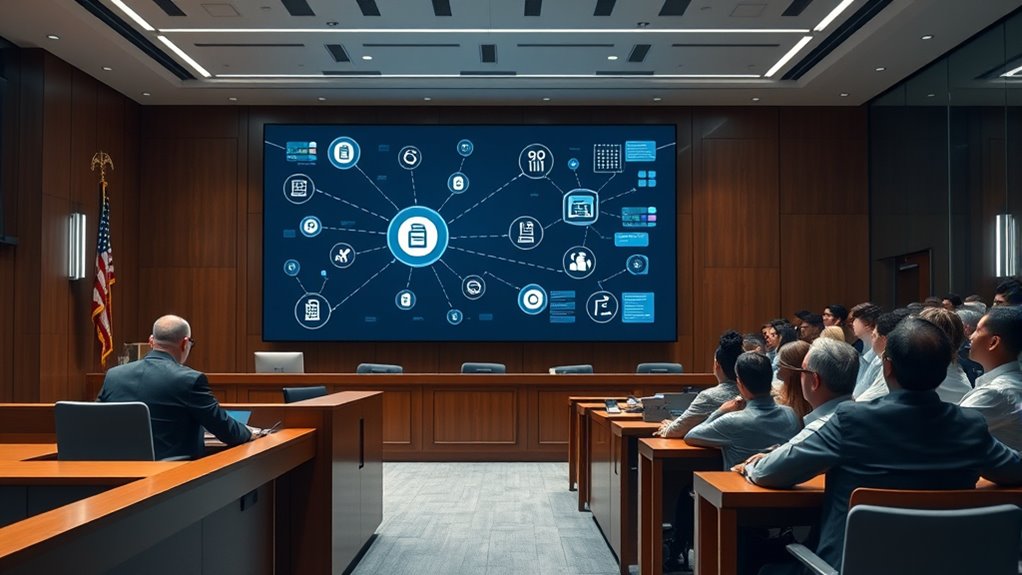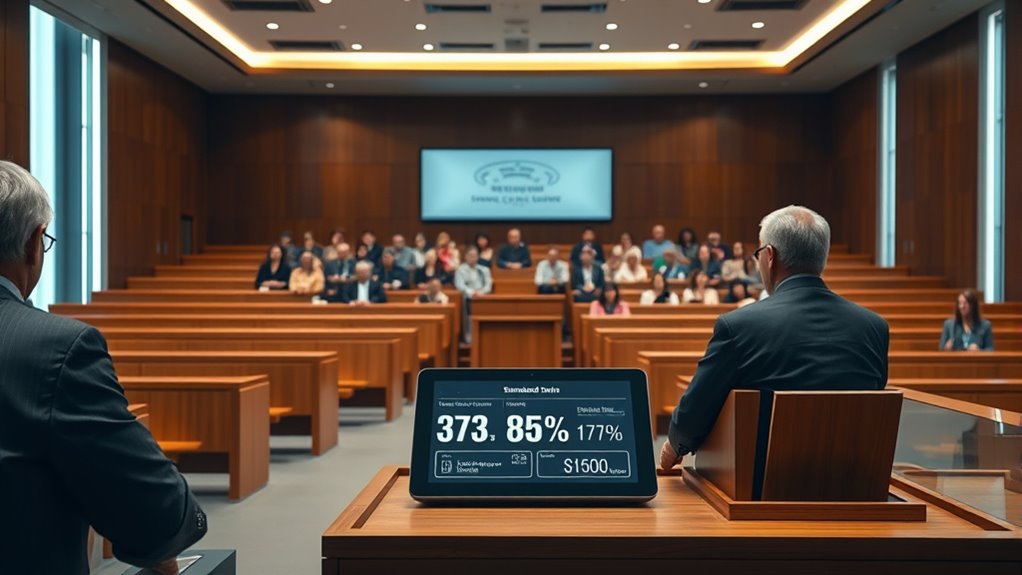Standardized judicial reporting helps you access clear, reliable information about court performance and decisions, making the justice system more transparent and understandable. When jurisdictions adopt uniform data collection and digital tools, you gain timely updates, easy access to case details, and increased trust in judicial processes. These improvements promote accountability and allow you to see how courts function across regions. To discover how these changes influence public trust and system efficiency, continue exploring how technology and global initiatives shape judicial transparency.
Key Takeaways
- Standardized judicial reporting ensures consistent, transparent data that enhances public understanding of court performance and processes.
- Uniform data collection fosters trust and accountability by providing reliable information accessible to the public.
- Digital platforms and dashboards make court data more accessible, promoting informed engagement and societal trust.
- Clear, comparable data supports reforms and policy decisions, improving judicial efficiency and public confidence.
- International standards and cooperation facilitate harmonized reporting, boosting transparency and public comprehension globally.
The Role of Data Standardization in Judicial Systems

Data standardization plays an essential role in modern judicial systems by enabling courts to compare performance and outcomes effectively across different jurisdictions. When data is standardized, you can analyze case processing times, conviction rates, and appeals consistently, regardless of location. This consistency helps identify best practices and areas needing improvement. By adopting uniform data collection methods and definitions, you reduce discrepancies that can obscure true performance. Standardization also supports transparency, making it easier for courts, government agencies, and the public to access clear, comparable information. With standardized data, you can track trends over time and evaluate reforms accurately. Implementing consistent measurement techniques further enhances the reliability of cross-jurisdictional comparisons. Additionally, establishing common terminology ensures all stakeholders interpret data uniformly, enhancing overall clarity. Incorporating data accuracy and quality controls is crucial to maintaining the integrity of the information collected and analyzed. Furthermore, integrating interoperable data systems can facilitate seamless data sharing between jurisdictions, fostering collaboration and comprehensive analysis. Utilizing standardized reporting formats can also improve data clarity and comparability across different systems. Ultimately, this promotes a more efficient, accountable, and fair justice system, ensuring that all jurisdictions meet shared standards of justice and performance.
Overcoming Challenges in Implementing Reporting Standards

You may encounter resistance from courts and officials who see standardized reporting as a threat to their autonomy. Technological barriers, like limited access to advanced systems, can also slow progress. Addressing these challenges requires clear communication, targeted training, and adaptable solutions. Implementing risk assessment practices can help identify and mitigate potential obstacles early in the process. Additionally, fostering a collaborative environment among stakeholders can facilitate smoother adoption of reporting standards and reduce resistance. Incorporating AI-driven analytics can further support data accuracy and transparency in reporting efforts, especially as emerging Advanced Techniques evolve to enhance judicial transparency. Leveraging best practices in data management can also improve consistency and trust in the reporting process.
Data Standardization Resistance
Implementing standardized reporting standards in judicial systems often faces significant resistance, especially in decentralized courts where local officials value autonomy. You’ll encounter pushback due to concerns over losing control and transparency. To overcome this, focus on:
- Engaging stakeholders early to address fears and clarify benefits. Building trust among stakeholders is crucial for successful adoption.
- Providing tailored training that demonstrates how standards improve efficiency. Practical training helps reduce uncertainty and resistance.
- Building trust by showcasing successful pilot programs and data transparency. Demonstrating tangible outcomes can motivate acceptance.
- Recognizing that data standardization can enhance overall judicial accountability and public confidence. Additionally, understanding how sound waves influence brainwave patterns can inform the development of communication strategies that resonate effectively with diverse stakeholders. It’s also important to consider how privacy and security concerns may impact stakeholder willingness to adopt new standards. Incorporating technological innovations can further facilitate smoother implementation.
Resistance often stems from a perceived threat to independence, so emphasizing how standardization supports judicial integrity and public trust helps. Recognize that change requires patience, and collaboration with local officials can ease the transition. Staying transparent and highlighting shared goals encourages buy-in, making the shift to standardized reporting smoother.
Technological Implementation Barriers
Technological implementation barriers pose significant challenges to establishing effective reporting standards in judicial systems. You may encounter limited access to digital infrastructure, especially in decentralized courts or regions with underfunded technology. Resistance from staff unfamiliar with new systems can slow adoption, as personnel may lack necessary training or fear job security impacts. Data quality issues, such as inconsistent formats or incomplete records, hinder automation and analysis efforts. Additionally, legal frameworks and practices vary across jurisdictions, complicating standardization of digital tools. Budget constraints also limit investment in advanced case management and analytics platforms. Overcoming these barriers requires targeted training, international collaboration, and phased technological upgrades. Furthermore, data standardization is essential to ensure interoperability and consistency across different systems. Without addressing these challenges, implementing standardized reporting remains difficult, impeding transparency, efficiency, and public understanding of judicial performance. Incorporating digital literacy initiatives can also facilitate smoother transitions to new reporting technologies, enhancing overall compliance and effectiveness. Moreover, the integration of AI-driven tools can help automate data analysis and improve accuracy in reporting processes. Additionally, fostering technological innovation within the judicial sector can accelerate the development of more adaptable and resilient reporting solutions.
Enhancing Transparency With Digital Technologies

Digital platforms make it easier for you to access judicial information and stay informed about ongoing cases. Real-time data sharing allows courts to update the public instantly, increasing transparency and trust. By embracing these technologies, you can better understand how justice is administered and hold systems accountable. Implementing data-driven strategies in judicial reporting can further enhance accuracy and credibility. Additionally, integrating standardised reporting methods ensures consistency across different jurisdictions, making information more accessible and understandable for the public. Incorporating principles of organization and clarity from home improvement practices can also contribute to more transparent communication.
Digital Platforms for Access
Digital platforms have revolutionized public access to judicial information by making court records, decisions, and proceedings readily available online. You can now easily find case details, rulings, and court schedules without visiting courts physically. This transparency builds trust and understanding in the justice system. Here’s how digital platforms enhance access:
- Centralized Portals: They serve as one-stop shops for all court-related information, reducing confusion.
- Search Functionality: You can quickly locate specific cases or decisions using simple keywords or filters.
- Accessibility Features: Platforms often include options for people with disabilities, ensuring everyone can access information.
Real-Time Data Sharing
Real-time data sharing transforms transparency by providing instant access to current court information, allowing you and others to stay updated on ongoing cases and system performance. With digital platforms, courts can share case statuses, rulings, and procedural updates immediately, reducing delays and uncertainty. This openness fosters public trust and accountability, as stakeholders can monitor judicial activities without waiting for periodic reports. Advanced data-sharing tools enable officials to identify bottlenecks or issues quickly, facilitating prompt responses and reforms. As courts adopt these technologies, you gain clearer insights into the judicial process, making justice more accessible and understandable. However, implementing real-time sharing requires robust data security and training to guarantee accurate, reliable information reaches everyone effectively.
International Initiatives Promoting Judicial Data Consistency

International organizations play a crucial role in promoting judicial data consistency across countries by developing frameworks, standards, and collaborative initiatives. They set guidelines that help courts share comparable information and improve transparency. Here’s how they support you:
- They create international standards, like those from UNESCO, to ensure courts worldwide use uniform reporting practices.
- They facilitate partnerships, such as the EU’s Justice Scoreboard, which monitors judicial performance across member states.
- They fund digital projects, like the World Bank’s support for digital case management, to make data collection more accurate and accessible.
These efforts help you understand how courts operate globally, promote transparency, and enable better comparisons. International collaboration ensures that judicial data remains consistent, dependable, and useful for public insight and reform.
Impact of Judicial Analytics on Public Trust

Judicial analytics markedly influence public trust by providing transparent and data-driven insights into court performance. When you have access to clear, reliable information about how courts operate, you’re more likely to trust the justice system. These tools reveal patterns, decisions, and efficiency levels, making judicial processes visible and understandable. As a result, you can better assess whether courts are fair, impartial, and effective. When courts share standardized data openly, it reduces doubts and perceptions of bias. additionally, analytics can highlight improvements or issues, fostering confidence that reforms are based on factual evidence. Ultimately, by promoting transparency and accountability, judicial analytics strengthen your trust in the legal system’s integrity and fairness.
Digital Platforms and Public Access to Court Information

As transparency and accountability become more integral to public trust, digital platforms play an essential role in making court information accessible to everyone. You can access case details, rulings, and judicial performance data quickly and conveniently online. To maximize these benefits, consider these key aspects:
Digital court platforms enhance transparency through accessible case details and real-time updates.
- User-Friendly Interfaces: Platforms should be easy to navigate, ensuring all users, regardless of technical skill, can find information efficiently.
- Real-Time Updates: Providing timely data helps the public stay informed about ongoing cases and legal developments.
- Open Data Initiatives: Sharing standardized and exhaustive court data fosters transparency and allows independent analysis.
Ensuring Judicial Independence Through Standardized Reporting

Standardized reporting plays a vital role in promoting transparency and safeguarding judicial independence. When you implement clear standards, you help guarantee courts can operate free from undue influence and maintain public trust. Strengthening judicial autonomy through consistent data also supports accountability across all levels of the judiciary.
Promoting Transparency Standards
Promoting transparency standards is essential for safeguarding judicial independence, as clear and consistent reporting practices prevent undue influence and enhance accountability. When you establish robust transparency measures, you help build public trust and reinforce the rule of law. To do this effectively, consider these key actions:
- Develop standardized reporting protocols that ensure consistent information sharing across courts.
- Implement digital platforms that allow easy access to case data and judicial performance metrics.
- Engage stakeholders—judges, officials, and the public—in ongoing dialogue to refine transparency practices.
Strengthening Judicial Autonomy
Strengthening judicial autonomy is essential for maintaining a fair and impartial legal system, and implementing standardized reporting practices plays a critical role in this effort. When courts adopt uniform data collection and reporting standards, they reduce external influences and enhance transparency, empowering judges to make decisions without undue pressure. Standardized reports provide objective performance metrics, helping safeguard judicial independence by highlighting systemic issues and resisting political interference. Technology-driven reporting systems further support this autonomy by offering consistent, reliable data that courts can use to justify decisions and defend their integrity. As a result, you guarantee that courts operate transparently and independently, fostering trust in the justice system. Clear, comparable data reinforces the rule of law and strengthens the judiciary’s position as an impartial arbiter.
Technology-Driven Improvements in Court Data Management

Technological advancements have revolutionized court data management by automating processes and enhancing accuracy. You now benefit from systems that streamline data collection and analysis, making information more reliable. Here are three key improvements:
- Automated Data Extraction: Case management systems automatically gather case details, reducing manual input errors.
- Data Analytics Tools: These tools analyze large datasets, revealing insights into judicial performance and decision trends.
- Digital Accessibility: Platforms enable public and officials to access court information easily, fostering transparency.
Addressing Barriers to Effective Data Standardization

While digital tools have improved court data management, significant barriers still hinder effective data standardization across jurisdictions. You may encounter resistance from decentralized courts or elected officials who see standardized reporting as a threat to control. Variations in legal frameworks and practices make aligning data formats challenging, causing inconsistencies that undermine comparability. Data quality issues, such as incomplete or inaccurate information, further weaken standardization efforts. Technological gaps, especially in regions with limited access to advanced systems, slow progress. Additionally, staff training remains essential; without proper education, personnel struggle to implement and maintain standardized processes. Overcoming these barriers requires coordinated efforts, clear guidelines, and investments in infrastructure, ensuring that data becomes a reliable tool for transparency, accountability, and public understanding.
Future Trends in Judicial Data and Public Engagement

As digital innovations continue to evolve, future trends in judicial data and public engagement are set to transform how courts operate and communicate with society. You’ll see more integrated analytics, making judicial data clearer and more accessible. Here are three key developments:
- Mainstreaming judicial analytics, helping judges and the public understand performance trends better.
- Expanding digital tools, like advanced case management systems, to boost transparency and efficiency.
- Enhancing public engagement, with user-friendly dashboards and online platforms that foster trust and understanding.
These innovations will promote data-driven reforms, improve transparency, and strengthen the connection between courts and society. Embracing these trends ensures justice systems become more open, accountable, and responsive to public needs.
Frequently Asked Questions
How Do Decentralized Courts Enforce Standardized Reporting Across Jurisdictions?
Decentralized courts enforce standardized reporting by implementing common digital case management systems and data protocols across jurisdictions. You must promote collaboration and training among court officials, encouraging adoption despite resistance. By leveraging technology and establishing clear reporting standards, you can guarantee consistency. Regular audits and feedback loops also help maintain compliance, fostering transparency and facilitating comparison of judicial data across different courts, even in decentralized structures.
What Privacy Concerns Arise With Increased Public Access to Judicial Data?
You might worry about privacy breaches, data misuse, or exposing sensitive information when increasing public access to judicial data. You could face risks of compromising individuals’ confidentiality, influencing ongoing cases, or enabling malicious actors to exploit information. Balancing transparency with privacy requires carefully regulated access, anonymized data, and strict security measures. You need to guarantee that public access enhances understanding without jeopardizing the rights and safety of those involved.
How Do Different Legal Systems Adapt to International Reporting Standards?
You’ll find that different legal systems adapt to international reporting standards by modifying their procedures to meet global benchmarks, often through legislative reforms or adopting new technologies. Some jurisdictions embrace digital case management and analytics tools, while others face resistance due to legal tradition or resource limitations. You may need to navigate varying levels of commitment and capacity, but international collaboration encourages gradual alignment and sharing best practices to promote transparency and consistency.
What Training Is Available for Judges to Utilize New Judicial Analytics Tools?
You can access training programs like UNESCO’s digital technology workshops, designed specifically for judges. For example, imagine you’re a judge learning to use judicial analytics tools to assess case trends. These trainings cover data interpretation, software navigation, and ethical considerations, empowering you to make informed decisions. Such programs enhance your skills, ensuring you leverage new technologies effectively, ultimately improving transparency and efficiency in your courtroom.
How Can Small or Resource-Limited Courts Implement Digital Reporting Systems Effectively?
You can start by prioritizing essential digital tools that fit your court’s capacity, such as basic case management systems. Seek support from international organizations or government programs that offer funding, training, and technical assistance. Collaborate with other courts to share resources and best practices, and gradually expand your digital infrastructure. Focus on developing staff skills through targeted training to guarantee smooth adoption and effective use of these systems.
Conclusion
By adopting standardized judicial reporting, you can substantially boost transparency and public trust. Did you know that courts using digital data systems see up to a 30% improvement in efficiency? Embracing technology and international best practices isn’t just about modernization—it’s about ensuring your justice system remains fair, transparent, and accountable. Moving forward, your commitment to data consistency will shape a more informed and confident society.







